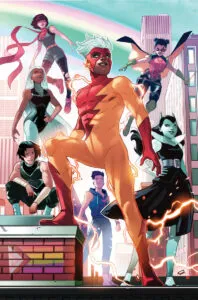
DC Pride is More Than Virtue Signaling
Ah, Pride Month. On the one hand, I love the outpouring of love for the LGBTQIA+ community. Rainbow flags, parades, and words of support and encouragement fill my social media feeds even more than normal. On the other hand, it’s the month when so many large corporations engage in worthless virtue signaling. So, when DC Comics announced their DC Pride event for 2022, I was skeptical.
What is virtue signaling? Why is it an issue? Virtue signaling is when a person or company does something just to show that they are virtuous. The term has become a pejorative in recent years because it describes giving these signals, but not doing anything substantial to back them up or keep the message going. While hundreds of companies will bring out rainbow variants of their company logos during Pride Month, they keep donating money to anti- LGBTQIA+ politicians and don’t do anything to support the LGBTQIA+ community.
The DC Pride event has several components to it. First is a 100-page anthology of 8-page stories about some of the LGBTQIA+ characters in DC Comics. Jonathan Kent, Batwoman, Nubia, Damian Wayne, Connor Hawke, and many other characters have been introduced or have come out in recent years. They’ve been appearing regularly or sporadically in different DC Comics titles, now brought together for a nice anthology.

DC Comics is also bringing out some one-offs like the young adult graphic novel, Galaxy: The Prettiest Star by Jadzia Axelrod and Jess Taylor and DC Pride: Tim Drake Special. There will be a pride version of the DC Comics logo and pride variant covers for many comic book issues throughout the month. So far, that all sounds nice, but also like virtue signaling.
Fortunately, there’s more. DC is also launching three ongoing series starring LGBTQIA+ characters: Poison Ivy, Nubia: Queen of the Amazons, and Multiversity: Teen Justice. Those three represent commitments beyond Pride Month. Here’s the real kicker, though. As far as I could gather from public information (DC did not respond to my request for comment), every creator working on that anthology identifies as part of the LGBTQIA+ community. This isn’t just throwing rainbows on books and going about business as usual. This is supporting and promoting the work of LGBTQIA+ artists and writers. This is telling LGBTQIA+ stories all year.

There are two sides to representation that are important when talking about comic books. First, it’s important for people to see themselves represented on the page. With the exception of intersex (I know we’re hard to write about, but come on!), every part of the LGBTQIA+ spectrum is represented in the anthology. Many of the characters are also BIPOC. This 100-page book is one of the most diverse I’ve ever read. People from so many walks of life, especially young people, can see themselves in capes and tights in those pages.
The other part of representation is in the creative talent. While some readers are content to read about people who look like them, some of us really want to write those stories. We need to know that people who look and sound like us can have jobs creating these stories. Over 30 creators were involved in the anthology as writers, artists, letterers, and editors. Fewer than half of them are cis men. A third of these artists are BIPOC. They all told their stories and got paid to do so.
DC Comics and its parent, WarnerMedia, are also partnering with Athlete Ally, Family Equality, Human Rights Campaign, Inside Out, Mermaids, PFLAG National, and The Trevor Project. They’re paying more than lip service to LGBTQIA+ issues, putting money into these organizations as well.

It’s important to note that there are no new characters created in the pages of the DC Pride Anthology. No coming-out stories. These characters have been out in the pages of DC Comics for a while, which itself tells us that DC Pride is more than virtue signaling. LGBTQIA+ representation populates multiple titles in DC Comics from month to month, and that representation is only increasing with the start of three new series.
DC Comics still has work to do, of course. While the creative representation for the anthology is wonderful, the creative talent at DC is still largely cis men. The biggest events each year at DC are still largely driven by the same old voices. Few of these LGBTQIA+ characters are appearing in DC’s big- or small-screen adaptations thus far. And, you know, I’d like to see some intersex representation. Nevertheless, the 2022 DC Pride event is definitely more than corporate virtue signaling.










